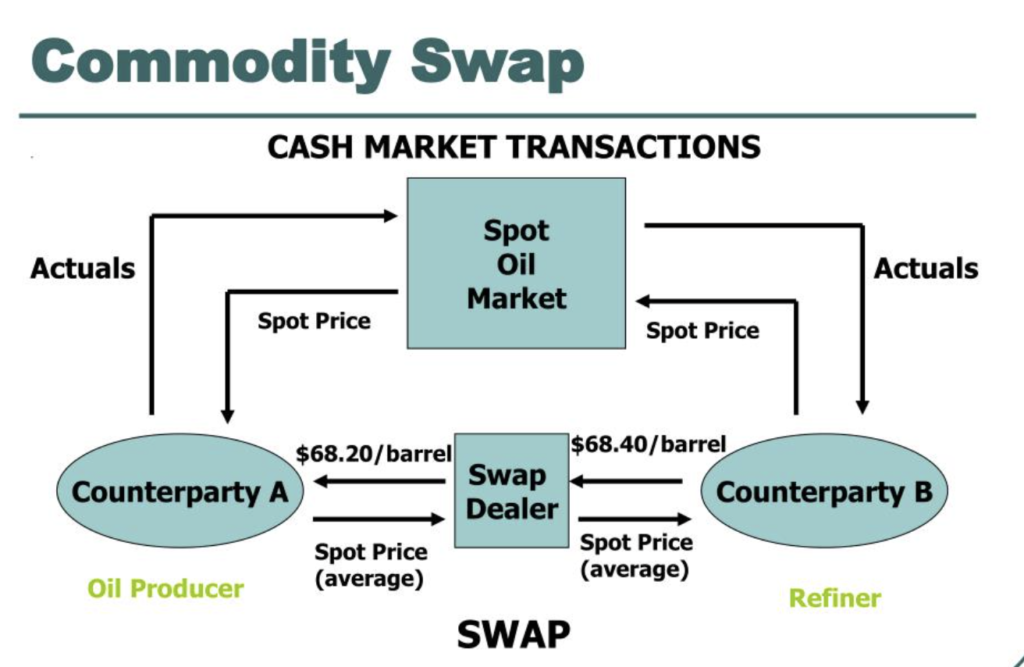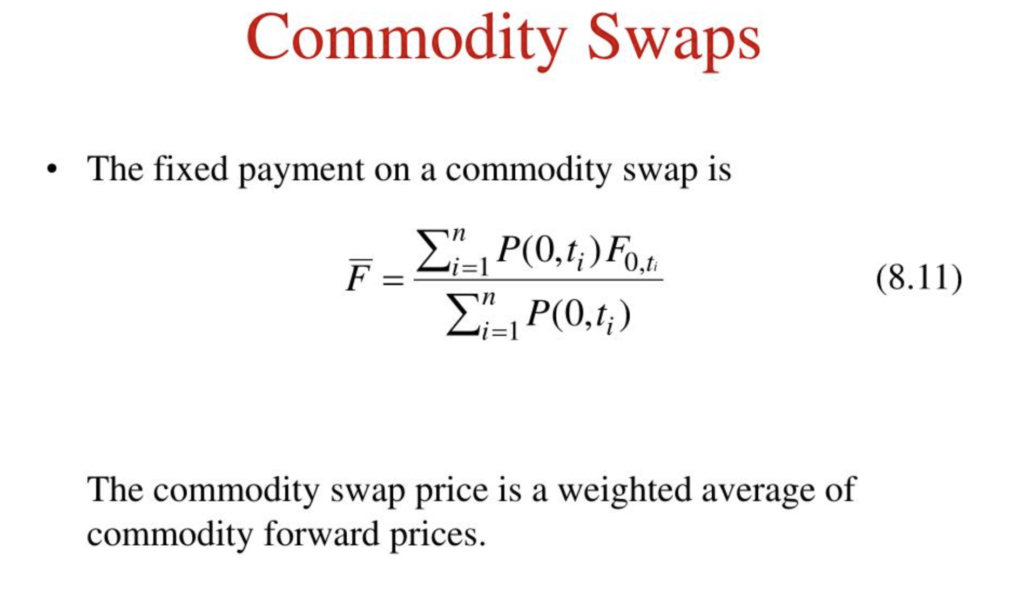A commodity swap is a financial contract in which two parties agree to exchange cash flows based on the price of a particular commodity. The purpose of a commodity swap is to hedge against fluctuations in the price of the commodity. For example, a producer of crude oil may enter into a commodity swap with a consumer of crude oil, where the producer agrees to receive a fixed price for their oil over a certain period of time, while the consumer agrees to pay that fixed price regardless of the actual market price.
Commodity swaps are popular among companies that are exposed to price risks associated with commodities, such as oil, gas, metals, and agricultural products. They allow companies to lock in prices for their products or inputs and reduce their exposure to market volatility.
In this blog article, we will explore the mechanics of commodity swaps, their advantages and disadvantages, and how they are used in various industries. We will also discuss the potential risks involved in commodity swaps and how to manage them effectively.

What Is A Commodity Swap?
Let’s say a coffee shop owner, who relies heavily on coffee beans, is worried about the potential rise in the price of coffee beans in the coming months due to various market factors. In order to hedge against the price risk, the coffee shop owner decides to enter into a commodity swap with a coffee bean producer.
The commodity swap agreement would specify a fixed price for a certain quantity of coffee beans to be delivered at a future date. Let’s say the fixed price is $2.50 per pound of coffee beans and the delivery date is six months from now. If the market price of coffee beans increases to $3.00 per pound, the coffee shop owner would still pay the fixed price of $2.50 per pound under the terms of the commodity swap. Conversely, if the market price of coffee beans falls to $2.00 per pound, the coffee shop owner would still pay the fixed price of $2.50 per pound, but would have effectively paid more than the market price.
The coffee bean producer, on the other hand, would benefit if the market price of coffee beans rises above the fixed price, as they would still receive the fixed price under the terms of the swap. If the market price falls below the fixed price, the producer would still receive the fixed price, but would have effectively sold the coffee beans at a higher price than the market price.
In this example, the commodity swap allows both parties to hedge against price risks associated with coffee beans. The coffee shop owner is assured of a fixed price for their coffee beans, while the coffee bean producer is protected against a drop in the market price of coffee beans. Now let’s talk about the advantage of commodity swaps.
Advantage of Commodity Swaps
One of the main advantages of commodity swaps is that they provide a way for companies to manage price risks associated with commodities. By entering into a commodity swap, companies can lock in a fixed price for a certain quantity of a commodity, thus reducing their exposure to market volatility. This can be especially important for companies that rely heavily on commodities as inputs in their production process or as products they sell.
Commodity swaps can also be used to manage the cash flows of a company. For example, a company that has a large cash surplus may use a commodity swap to invest in a commodity, while a company with a cash deficit may use a commodity swap to borrow money using the commodity as collateral.
Commodity swaps can also provide a way for companies to access new markets or expand their existing market presence. For example, a company that produces a commodity may use a commodity swap to sell the commodity to customers in a new market, while a company that needs a certain commodity as an input may use a commodity swap to secure a reliable supply of the commodity from a producer in a different region.
Overall, the advantages of commodity swaps include risk management, cash flow management, and market access. However, it is important to note that commodity swaps also come with risks and require careful consideration and management. Now let’s talk about the disadvantage of commodity swaps.
Disadvantage of Commodity Swaps
While commodity swaps can provide benefits, they also come with several potential disadvantages that companies should consider before entering into these contracts. Some of the disadvantages of commodity swaps include:
- Market risk: While commodity swaps can help companies manage price risks associated with commodities, they do not eliminate market risks entirely. If the market price of the commodity moves significantly in the opposite direction of the swap, one party may end up paying more than the market price, resulting in financial losses.
- Counterparty risk: Commodity swaps are entered into with a counterparty, which exposes both parties to the risk of the other party defaulting on the contract. This can lead to significant financial losses, especially if the counterparty is unable to fulfill their obligations.
- Legal and regulatory risk: Commodity swaps are subject to legal and regulatory requirements, which can vary depending on the jurisdiction and the type of commodity being traded. Failure to comply with these requirements can result in legal and financial penalties.
- Complexity: Commodity swaps can be complex financial instruments, requiring expertise and resources to understand and manage effectively. This can be a disadvantage for companies that do not have the necessary resources or expertise in-house.
- Liquidity risk: Commodity swaps can be illiquid, meaning that it may be difficult to find a counterparty to enter into or exit a swap contract. This can result in the inability to execute a desired trade or to exit a trade in a timely manner, which can lead to financial losses.
Overall, companies need to carefully consider the potential risks associated with commodity swaps and ensure that they have the necessary expertise and resources to manage these risks effectively before entering into these contracts.
Calculate The Commodity Swap Fixed Payment
The formula for a commodity swap fixed payment can be calculated using the following formula:
Fixed payment = (Notional amount x Fixed swap rate x Swap tenor) / (1 + Floating rate x Payment frequency) ^ (Swap tenor x Payment frequency)
Where:
- Notional amount is the total value of the swap contract
- Fixed swap rate is the fixed interest rate agreed upon in the swap contract
- Swap tenor is the length of the swap contract in years
- Floating rate is the market interest rate used to calculate the floating payment
- Payment frequency is the number of payment periods per year
The formula calculates the present value of the fixed payment to be made by one party to the other as part of the commodity swap agreement. The calculation takes into account the notional amount, the fixed swap rate, the length of the contract, and the market interest rate.
The payment frequency is used to calculate the number of payments made during the swap tenor. For example, if the payment frequency is semi-annual, there will be two payments made each year.
It’s important to note that the formula for a commodity swap fixed payment may vary depending on the specific terms of the contract. For example, you can also find the following, using the weighted average of commodity forward prices:

Conclusion
Commodity swaps have become an increasingly popular financial instrument for managing price risks associated with commodities. With their ability to provide certainty over commodity prices, these contracts have helped companies to hedge against market volatility and protect their bottom line.
While commodity swaps can offer benefits such as risk management, cash flow management, and market access, they also come with potential disadvantages. Companies must carefully evaluate the risks associated with commodity swaps and have the necessary expertise and resources to manage these risks effectively.
Despite these potential drawbacks, commodity swaps remain an attractive option for many companies. By entering into these contracts, companies can protect themselves against market risks, access new markets, and secure reliable supplies of commodities. They also provide a means of investing in or borrowing against commodities, which can be especially important for companies that operate in commodity-dependent industries.
As the global economy becomes increasingly interconnected and volatile, the importance of commodity swaps is likely to continue to grow. With the right strategy and expertise, companies can use commodity swaps to their advantage and achieve long-term success in the market.
n.b: this is not financial advice

